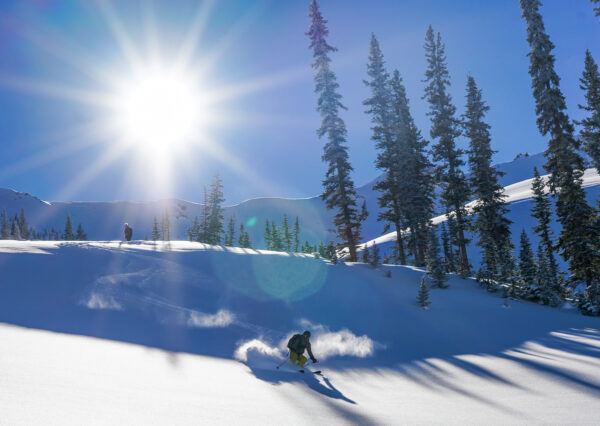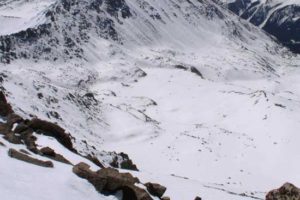A mellow ski tour to assess backcountry conditions

The skies cleared, the wind abated, the forecast called for sun. Maybe it was a good opportunity for a backcountry ski tour?
It had been a week since our storm cycle had passed, giving the local snowpack some much-needed time to settle and stabilize. The morning avalanche reports noted a downtrend in the avalanche risk— the official Colorado Avalanche Information Center (CAIC) rating for the Elk Mountains was moderate, one level above low. But also included in those reports were some alarming photos of large natural avalanches and some stern warnings of potential hazards.
The mixed messaging can leave a skier with more questions than answers. Sure, the overall moderate rating provides some confidence. But the acknowledgment that considerable risks still exist can lead to some confusion. Is it safe, or is it dangerous?
The actual answer is that it’s a little bit of both. Welcome to Colorado in January, where this kind of setup in the backcountry is par for the course.
It’s the nature of the snowpack for a mountain range that is inland, high, and often dry. We don’t have the heavy, high moisture content snow that falls nearer the coast. The light dry powder we usually see, which we all wish for on the ski areas, brings various instabilities in the backcountry.
But just because there are instabilities and avalanche risks doesn’t mean backcountry skiing should be considered off-limits. The decision as to whether or not it’s safe or wise to venture into the backcountry isn’t a binary one. Conditions are never so black and white that you can say it’s 100% safe or completely dangerous.

Terrain choices matter. Choosing lower-angled slopes or safer aspects can keep you out of trouble. Safety protocols exist because they’ve been proven to work. The experienced backcountry skier knows this. They acknowledge that there are risks to consider each day you go out into the mountains— whether the avalanche rating is low, high, or somewhere in-between. If you’ve been doing it long enough, you learn how to manage it.
It’s definitely beneficial to stay abreast of news and updates from the CAIC website, or the more local Crested Butte Avalanche Center. But backcountry skiers also know that there’s only so much you can glean from an online avalanche report. For a complete picture of what conditions are like, you need to go and see for yourself.
With our recently fortified snowpack, my wife and I decided to go on a backcountry ski tour and check out the conditions. We rallied a friend to make a group of three, and after bouncing some ideas off each other, we came up with a plan.
In our experience, when heading into the backcountry, it’s essential to agree on your goals and objectives beforehand. It’s also a good idea to have an alternate, more conservative Plan B.
Heading out with only a Plan A and no other options can lead to problems. You may find yourself ignoring unexpected red flags and stubbornly sticking with the single objective to avoid the disappointment of retreat. Unfortunately, there are countless examples of backcountry accidents related to this single-minded error.
An alternate Plan B gives you the option to scrap the original objective if you encounter unexpected conditions. You can salvage the ski day by pivoting to the backup plan and pursuing a more conservative goal.

So with a couple of options in mind, we headed out.
It was a beautiful day— sunny and cold with no wind. The zone where we hoped to ski required a three-mile approach. We took advantage of the time on our skins to look around, make some observations, and note any signs of instability. We saw a couple of older, natural slides, most likely from earlier in the week, but little else.
Once the approach was behind us, it was time to start climbing. We took turns breaking trail, setting a proper skin track with gentle switchbacks. We saw no shooting cracks or experienced any “whoompfing” or settling. When you climb what you ski, you can get a good feel for conditions. If you access the backcountry via chairlift, you lose the ability to assess the snowpack on the way up.
After 40 minutes of skinning, without noting any instabilities, we transitioned to ski. We were below treeline, which the CAIC forecast recommended as being safer than terrain at higher elevations. Our ski descent was through gladed terrain, which is also a conservative option. Wide avalanche paths, while clear of trees and ideal for skiing, only exist because prior avalanches created them. Consider that fact when you’re organizing your tour plan.
We skied a lap, and then a second, and found everything to be supportive. Random probes of the snow showed it to be around 5 feet deep, which is pretty good for early January. There was new snow from our recent storm, which sat on the stable, settled base.

We were able to stick to our Plan A and feel as though we stayed within everyone’s comfort zone. Looking at the bigger picture, we thought the conditions were encouraging. If we continue to receive an average amount of snowfall in the months ahead, we should be set up for a good spring backcountry season.
So is it safe to go in the water?
Well, I can’t offer a yes or no answer. It’s not that simple. We had a good time, everything went smoothly. But basing your decisions on anecdotal information from others is a mistake. Every day and every location is different, and you have to make your own decisions each and every time you head out.
That’s an important point. The appearance of ski tracks somewhere or noting that someone skied a particular line on social media isn’t a green light indicating everything is good to go. How do you know there weren’t close calls, red flags, or other instabilities? Can you be certain conditions haven’t changed since those skiers were there?
You need to do your own homework. That’s not a chore, it’s actually part of the appeal of backcountry skiing— it’s better with solid planning and decision making. The outcome is never guaranteed. When you put together a successful backcountry tour, it’s really rewarding.
We did what we set out to do — we skied and got to see the snowpack up-close. It’s only January— the backcountry season is just getting started. Conditions will only improve as we head further into spring. But it’s never too early to get out there, poke around, and see firsthand what is happening with the snow. When spring arrives, you’ll have a better sense of things, which means fewer surprises, safer outcomes, and more fun for everyone.











Leave a Reply